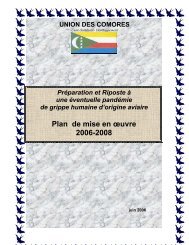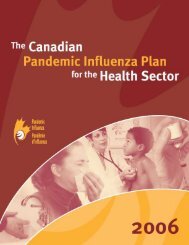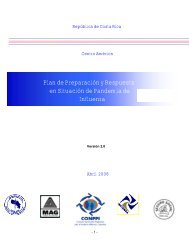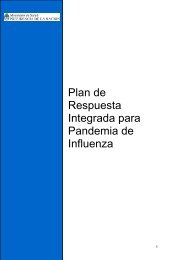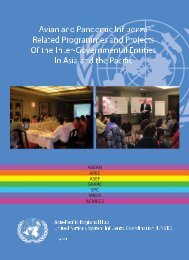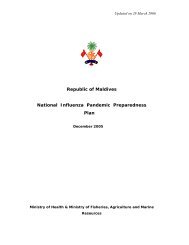GES Simulation Guide v3.pdf - Avian Influenza and the Pandemic ...
GES Simulation Guide v3.pdf - Avian Influenza and the Pandemic ...
GES Simulation Guide v3.pdf - Avian Influenza and the Pandemic ...
You also want an ePaper? Increase the reach of your titles
YUMPU automatically turns print PDFs into web optimized ePapers that Google loves.
ABOUT<br />
THIS<br />
GUIDE<br />
<strong>Simulation</strong> exercises have gained increasing prominence in humanitarian preparedness<br />
over <strong>the</strong> past several years, particularly by <strong>the</strong> organisations comprising <strong>the</strong> Inter-Agency<br />
St<strong>and</strong>ing Committee (IASC). <strong>Simulation</strong>s serve to test plans, rehearse procedures,<br />
identify gaps, solve problems, increase confidence <strong>and</strong> generally add to <strong>the</strong> overall<br />
capacity of organisations <strong>and</strong> individuals to react to emergencies in an effective, timely <strong>and</strong><br />
reliable manner. In any life-saving profession--pilots, fire-fighters, para-medics--drills<br />
<strong>and</strong> practice are required to achieve <strong>the</strong> best results. The IASC Sub-Working Group on<br />
Preparedness, co-chaired by UNICEF <strong>and</strong> WFP, feels strongly that simulation exercises are<br />
vital to improve <strong>the</strong> quality of humanitarian action. Accordingly, this guide aims to put at<br />
<strong>the</strong> disposal of Government emergency managers an easy-to-use methodology for running<br />
simulation exercises in order to enhance <strong>the</strong>ir national agencies’ level of preparedness.<br />
This guide was compiled by an inter-agency emergency simulation training team based<br />
on <strong>the</strong> training course for simulation facilitators held in S<strong>and</strong>ö, Sweden in 2010 <strong>and</strong> 2011,<br />
organised by <strong>the</strong> IASC Sub Working Group on Preparedness <strong>and</strong> supported by MSB, <strong>the</strong><br />
Swedish Civil Contingency Agency. The guide is intended as a tool for national governments<br />
who wish to conduct simple, inexpensive table top <strong>and</strong> functional exercises to test systems<br />
<strong>and</strong> procedures contained within <strong>the</strong>ir national disaster management plans. The design of<br />
this guide has been a collaborative effort of <strong>the</strong> Inter-Agency St<strong>and</strong>ing Committee’s Sub-<br />
Working Group on Preparedness. The SWG on Preparedness would like to acknowledge<br />
<strong>the</strong> valuable support of Allan Bell, Ian Clarke, Fred Spielberg, Gunilla Lindstrom, Shelby<br />
Ruiz, David Knaggs, Pierre Gelas, James Staples <strong>and</strong> Elroi Yee.<br />
Michel Le Pechoux, UNICEF<br />
Co-Chair of <strong>the</strong> IASC SWG on<br />
Preparedness<br />
Anthony Craig, WFP<br />
Co-Chair of <strong>the</strong> IASC SWG on<br />
Preparedness



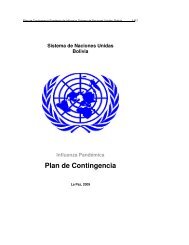
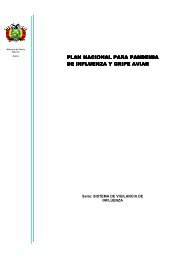
![Tanzania National Plan (January 2007)[1].pdf - Avian Influenza and ...](https://img.yumpu.com/36423433/1/190x245/tanzania-national-plan-january-20071pdf-avian-influenza-and-.jpg?quality=85)
